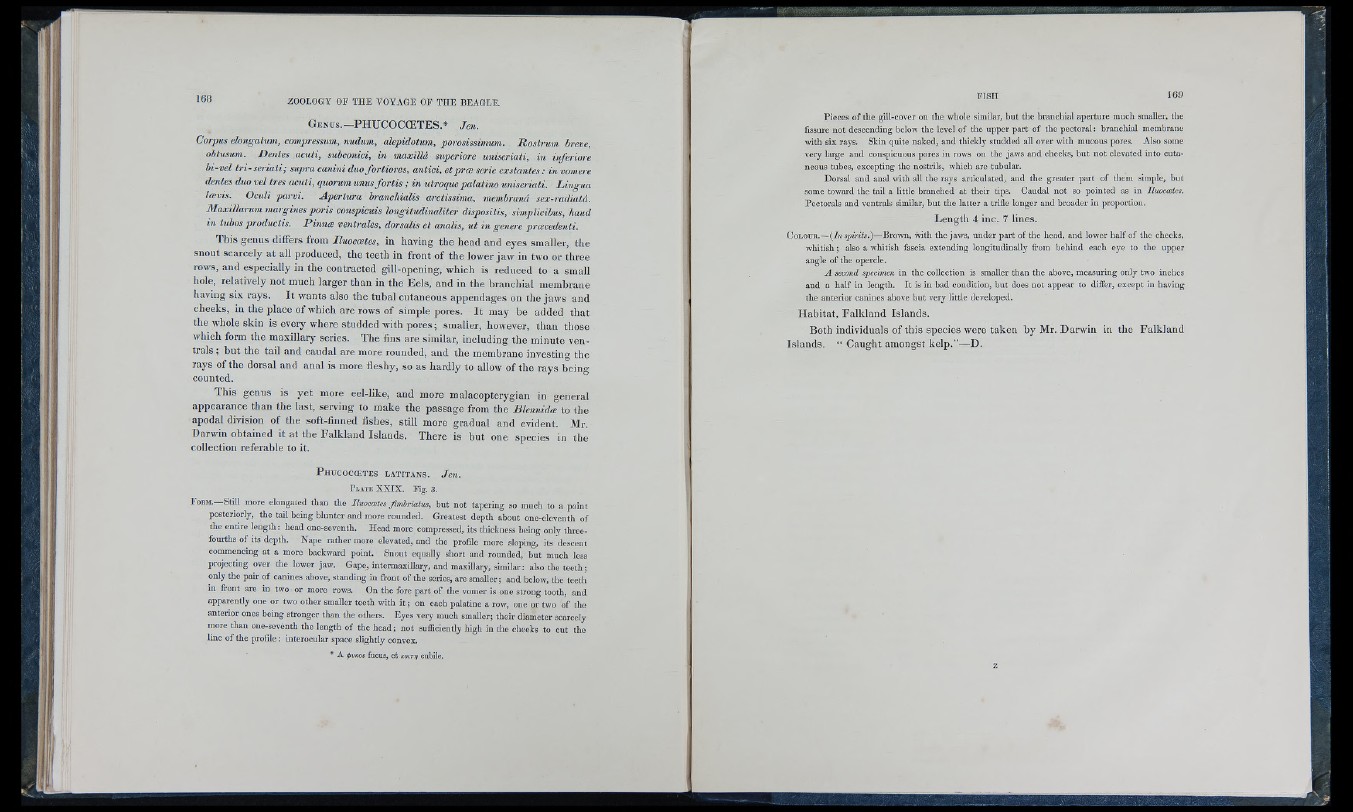
Genüs.-PHÜCOCOETES.» Jen.
Corpus elongatmn, compressum, nudum , alepidotum, porosissimum. R o strum hreve,
obtusum. Deities acuti, subconici, in m axilU superiore uniseriati, in inferiore
bi-vel tri-seria li; supra canini duo fortiores, antici, et p ræ serie exstantes: in vomere
denies duo vel 1res acuti, quorum unus fo r tis ; in utroc[ue palatino uniseriati. L in g u a
lævis. Oculi parvi. A pertura hranchialis arctissima, membranâ sex-radiatâ.
A laxillarum margines poris conspicuis longitudinaliter dispositis, simplicibus, haud
in tubos productis. P innoe ventrales, dorsalis et analis, u t in genere proecedenti.
This genus differs from Iluocoetes, in having the head and eyes smaller, the
snout scarcely at all produced, the teeth in front of the lower jaw in two or three
rows, and especially in the contracted gill-opening, which is reduced to a small
hole, relatively not much larger than in the Eels, and in the branchial membrane
having six rays. It wants also the tubal cutaneous appendages on the jaws and
cheeks, in the place of which are rows of simple pores. It may be added that
the whole skill is every where studded with pores ; smaller, however, than those
which form the maxillary series. The fins are similar, including the minute ventrals
; but the tail and caudal are more rounded, and the membrane investing the
rays of the dorsal and anal is more fleshy, so as hardly to allow of the rays being
counted.
This genus is yet more eel-like, and more malacopterygian in general
appearance than the last, serving to make the passage from the B lennidæ to the
apodal division of the soft-fiiined fishes, still more gradual and evident. Mr.
Darwin obtained it at the Falkland Islands. There is but one species in the
collection referable to it.
P h u c o c c e te s l a t i t a n s . Jen.
P l a t e XXIX. F i g . 3 .
F o e m . — Still more elongated than the Iluocoetes Jimhriatus, but not tapering so much to a point
posteriorly, the tail being blunter and more rounded. Greatest depth about one-cloventh of
the entire length : head one-seventh. Head more compressed, its thickness being only three-
fourths of its depth. Nape rather more elevated, and tho profile more sloping, its descent
commencing at a mote backward point. Snout equally short and rounded, but much less
projecting over the lower jaw. Gape, intermaxillary, and maxillary, similar: also tho tooth;
only the pair of canines above, standing in front of the scries, are smaller ; and below, the teeth
in front are in two or more rows. On the fore part of the vomer is one strong tooth, and
apparently one or two other smaller teeth with it ; on each palatine a row, one or two of tho
anterior ones being stronger than the others. Eyes very much smaller; their diameter scarcely
more than one-seventh the length of the head; not sufficiently high in the checks to cut tho
line of the profile : interocular space slightly convex.
* A fvKos fucua, et koitti cubilc.
Pieces of the gill-cover on the whole similar, but the branchial aperture much smaller, tbe
fissure not descending below the level of the upper part of the pectoral: branchial membrane
with six rays. Skin quite naked, and thickly studded all over with raucous pores. Also some
very large and conspicuous pores in rows on the jaws and cheeks, but not elevated into cutaneous
tubes, excepting the nostrils, which are tubular.
Dorsal and anal with all the rays articulated, and the greater part of them simple, but
some toward the tall a little branched at tbeir tips. Caudal not so pointed as in H uocilUs .
Pectorals and ventrals similar, but the latter a trifle longer and broader in proportion.
Length 4 inc. 7 lines.
C o l o u r . — {In spirits.)—Brown, with the jaws, under part of the bead, and lower half of the cheeks,
whitish; also a whitish fascia extending longitudinally from behind each eye to the upper
angle of the opercle.
A second specimen in the collection is smaller than the above, measuring only two inches
and a half in length. It is in bad condition, but does not appear to differ, except in having
the anterior canines above but very little developed.
Habitat, Falkland Islands.
Both individuals of this species were taken by Mr. Darwin in the Falkland
Islands. “ Caught amongst kelp.”—D.